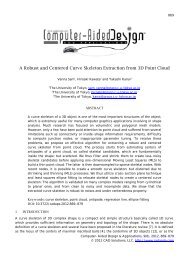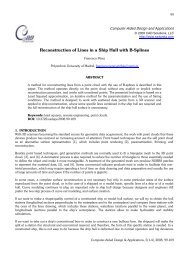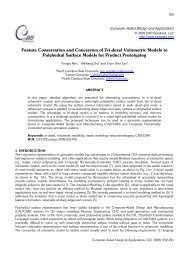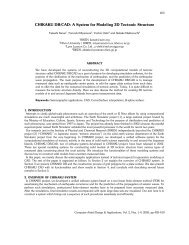A Virtual Sculpting System Based on Triple Dexel Models with Haptics
A Virtual Sculpting System Based on Triple Dexel Models with Haptics
A Virtual Sculpting System Based on Triple Dexel Models with Haptics
You also want an ePaper? Increase the reach of your titles
YUMPU automatically turns print PDFs into web optimized ePapers that Google loves.
646<br />
allows the user to visualize CAD models in a virtual envir<strong>on</strong>ment immersively. Incorporating a haptic<br />
interface to the virtual sculpting system provides the user <strong>with</strong> a more realistic experience. Force<br />
feedback enables the user to feel the model creati<strong>on</strong> process like actual sculpting <strong>with</strong> physical<br />
materials. To c<strong>on</strong>tinuously provide a stable sensati<strong>on</strong> of touch, an update rate of at least 1,000 Hz is<br />
required for the haptic rendering [6, 24]. Less than 1 kHz update rate will result in uncomfortable<br />
percepti<strong>on</strong> of fricti<strong>on</strong>, ridges, and general roughness.<br />
Previously the authors have developed a virtual sculpting system based <strong>on</strong> single-dexel modeling and<br />
sweep differential equati<strong>on</strong> algorithm [19], [20]. In the single-dexel model, low sampling quality occurs<br />
in regi<strong>on</strong>s where the surface normals are nearly perpendicular to the ray directi<strong>on</strong>. This paper presents<br />
a new sculpting system <strong>with</strong> triple-dexel modeling which overcomes the drawback of previous system.<br />
In our virtual sculpting system, the workpiece and the sculpting tool are both represented by tripledexel<br />
models. The sculpting tool is c<strong>on</strong>trolled by a force-reflective input device. <str<strong>on</strong>g>Virtual</str<strong>on</strong>g> sculpting is<br />
implemented via a series of Boolean operati<strong>on</strong>s that computati<strong>on</strong>ally subtract/unite successive tool<br />
volumes from the workpiece. The Boolean operati<strong>on</strong> is performed between the dexel representati<strong>on</strong> of<br />
the tool volume and that of the workpiece by comparing the sorted depth data for each dexel in x, y<br />
and z directi<strong>on</strong>s. The haptic device PHANToM Omni is used as an input device to provide the positi<strong>on</strong><br />
and orientati<strong>on</strong> data of the sculpting tool, and it is also used as an output device to provide force<br />
feedback during sculpting. The freeform workpiece can be c<strong>on</strong>verted into triangular mesh models<br />
using the novel triple-dexel surface rec<strong>on</strong>structi<strong>on</strong> method [31].<br />
The sculpting system has the following merits. First, the sculpting process is simulated by removing<br />
and attaching material which is analogous to real life sculpting. Therefore, it is intuitive and easy to<br />
operate. Sec<strong>on</strong>d, compared to voxel data based sculpting system, the developed system is more<br />
efficient in terms of computati<strong>on</strong>al complexity and memory cost and the sculpted models are more<br />
accurate. Furthermore, the topology ambiguity problem in the mesh generati<strong>on</strong> is avoided in the<br />
system, which is generally the challenge suffered by most mesh based sculpting system. Finally, the<br />
rec<strong>on</strong>structed mesh surface model can be output to CAD/CAM/CAE systems to perform geometric<br />
design, engineering analysis, and automated manufacturing applicati<strong>on</strong>s. For example, the<br />
rec<strong>on</strong>structed mesh surface can be stored as a STL file which is widely accepted by CAD/CAM/CAE<br />
software.<br />
The rest of the paper is structured as follows. In Secti<strong>on</strong> 2, related works are reviewed. Secti<strong>on</strong> 3<br />
presents details <strong>on</strong> the triple-dexel model and Boolean operati<strong>on</strong>s. Mesh generati<strong>on</strong> techniques are<br />
presented in Secti<strong>on</strong> 4 and haptic rendering are discussed in Secti<strong>on</strong> 5. Secti<strong>on</strong> 6 shows the<br />
implementati<strong>on</strong> results. C<strong>on</strong>clusi<strong>on</strong>s are drawn in Secti<strong>on</strong> 7.<br />
2. Related Work<br />
2.1 Geometric <strong>Models</strong> in <str<strong>on</strong>g>Virtual</str<strong>on</strong>g> <str<strong>on</strong>g>Sculpting</str<strong>on</strong>g><br />
Solid modeling technique is the kernel of a virtual sculpting system which mathematically represents<br />
the freeform models. Various solid modeling techniques have been developed in support of virtual<br />
sculpting. Three types of geometric modeling methods are mostly used: boundary representati<strong>on</strong>s (Breps)<br />
based <strong>on</strong> polyg<strong>on</strong>al meshes, Spline-based surface or solid, and discrete scalar fields.<br />
Mesh based sculpting system: In Jagnow and Dorsey’s virtual sculpting system, the polymesh geometry<br />
is partiti<strong>on</strong>ed into coarse slabs <strong>with</strong> the detailed features stored as displacement maps at each surface<br />
[11]. Nienhuys presented a surface cutting method using Delaunay Triangulati<strong>on</strong> in deformable objects<br />
[18]. Knopf and Igwe [13] developed a virtual sculpting framework base <strong>on</strong> mesh models represented<br />
by a self-organizing feature map (SOFM). A dental surgery simulati<strong>on</strong> was developed by Wang et al. in<br />
which the tooth and tool are modeled using triangle mesh [28]. Gunn [7] introduced a collaborative<br />
haptic virtual sculpting envir<strong>on</strong>ment in which the deformati<strong>on</strong> of virtual clay is simulated by<br />
transforming the vertices of the polyg<strong>on</strong>al model.<br />
Spline-based sculpting system: W<strong>on</strong>g et al. [29] developed a <str<strong>on</strong>g>Virtual</str<strong>on</strong>g> 3D <str<strong>on</strong>g>Sculpting</str<strong>on</strong>g> system based <strong>on</strong> a<br />
parametric c<strong>on</strong>trol hand surface which is defined by an Open-Uniform B-Spline tensor product surface.<br />
Computer-Aided Design & Applicati<strong>on</strong>s, 6(5), 2009, 645-659








